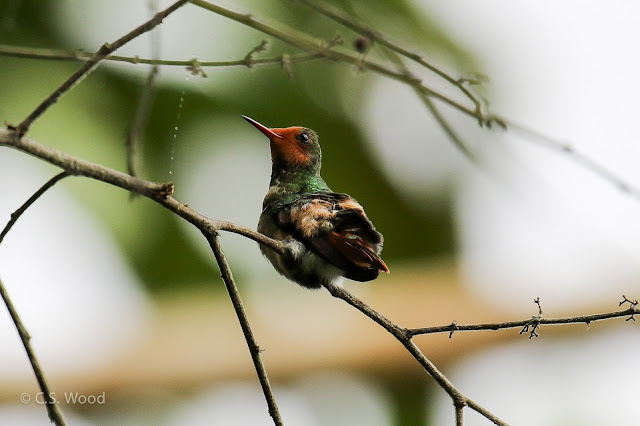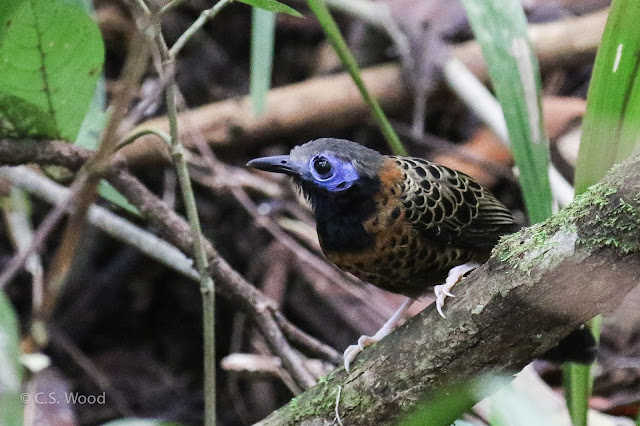OK, I titled this post "Isthmian Life Birds" just to make you try to pronounce "isthmian" when I could easily have used "Panamanian." But it is about a birding trip to many of Panama's prime bird locations for life birds and photos.
Organized by Ed, a world birder seeking to add to an already impressive list, we took advantage of the exceptional services of the Canopy Family, lodging at Canopy Camp in the Darien and Canopy Tower in the Canal Zone near Panama city. Check out the history and offerings of Raul Arias de Para's terrific operation here: http://www.canopytower.com
Raul is among many Panamanian leaders who recognize that the natural beauty and healthy ecosystems of the isthmus need to be protected and promoted, for their own good and that of the people of the country. Based on our brief visit it seems to be working, at least on a small scale.
Dating back at least to Frank Chapman's research on Barro Colorado early in the 20th century, Panama has been known for its amazing bird diversity. In the company of Ed and Linda, Mark and Linda, Chrissy, Becky, and Dan, we set on on a quest for the Harpy Eagle and other Panama specialties.
The Harpy Eagle Trek is detailed in a separate Blog post, below
Of course, hundreds of spectacular birds, myriad wildlife, and heretofore unseen scenes provide a mission backdrop unlike any other. We ended up with some 251 birds, over 25% of all birds recorded in Panama. (Full list in a separate Post, below) Of those, 42 were new to Ed, well exceeding the 25 or so he anticipated. And when you're birding with someone who has seen over 6000 birds worldwide, pretty much any lifer for him will be a good bird for you, too. So this post will run through our trip using Ed's lifers as a connecting thread.
Roadside Ed
On the way to Canopy Camp, a roadside stop yielded a Green and Rufous Kingfisher, not an Ed lifer but a pretty rare bird. Then a stop at the San Fransisco Preserve, a fascinating nature, water, and agricultural site providing water, food, and jobs for the local community, as well as fantastic birding opportunities for tourists. Birds were moving too fast around us to permit adequate attention to the full story of the place: something about a Catholic priest from Wisconsin (whom we met - quite a fellow) and a water pipeline dug by hand by the community.
Alas, socioeconomic observations could not compete with the birds. At least one Ed lifer, an aptly-named Plain-colored Tanager, was ticked here, along with dozens of birds new to the rest of us, including a Lineated Woodpecker, kin to our own Pileated.
Lineated Woodpecker
Plain-colored Tanager
On to lunch at a roadside eatery in Torti, where meals are served a la hummingbird, with several feeders dishing up eight or more species. New for Ed were Snowy-bellied Hummingbird and Pale-bellied Hermit. In addition to the birds, new for me was a slab of "pork" that could have been about anything, but delicious with rice and beans.
Snowy-bellied Hummingbird
Canopy Camp overwhelms the birder with hummingbirds. They are nearly oblivious to us as they fight over the feeders, often insisting that you get out of their way, can't you see I'm trying to eat? And even checking out that red spot on the logo on your hat. Photography becomes addictive, as Becky said, with many birds buzzing around the flower bushes including a few Ed lifers: the Blue-throated Goldentail, the Rufous-crested Coquette, the Sapphire-throated Hummingbird, and the Violet-bellied Hummingbird. (The descriptive and usually logical naming of neotropic birds will be the subject of a future Post.)
Violet-bellied Hummingbird
Blue-throated Goldentail
Rufous-crested Coquette (female)
Sapphire-throated Hummingbird
Raucous Oropendolas rattle through the camp grounds, Geoffroys Tamarin and White-faced Capuchin monkeys gorge on bananas, and just outside the clearing, the jungle hides Ed lifers White-headed Wren and Red-crowned Manakin (although Ed had to wait for Pipeline Road to get the latter).
Day 3 took us out on the Rio Chucunaque in search of the Dusky-backed Jacamar. Expert Panamanian guide Carlos had only seen this bird for the first time in 2015, and had a site staked out a few miles up the river in dug-out canoes. Lots of cool stuff along the way, capped by great looks at a pair of the Jacamars.
Dusky-backed Jacamar
Barred Puffbird was also an Ed lifer on this trip.
Barred Puffbird
The day after our Harpy Eagle trek, we made repeat stops at San Francisco Preserve and Torti (for lunch again, this time "chicken" with rice and beans), and then moved to Canopy Tower. A converted US military radar installation within the former Canal Zone, the Tower is a birding venue beyond compare. From the top deck, canopy birds are feeding below you, and distant views of ships navigating the famed Culebra Cut in the Panama Canal add to a sense of other-worldliness.
Canopy Tower Observation Deck
Culebra Cut, Panama Canal
The famous Pipeline Road in nearby Gamboa lived up to its reputation, especially when we came upon an army ant swarm accompanied by numerous species of Antbirds and Woodcreepers; like hummingbirds at feeders they were seemingly oblivious to our camera lenses and several of them were Ed lifers.
Ocellated Antbird
Spotted Antbird
Black-breasted Puffbird
Southern Bentbill (sadly, hiding its bent bill)
Our last outing was along the Chagres River, where Ed's final trip lifer was a Collared Forest-Falcon.
Collared Forest-Falcon
Extraordinary photo opportunities, even with the difficult lighting conditions, and I managed to capture about 16 of Ed's lifers. More photos from the trip may be seen here:
https://www.flickr.com/gp/cswood-photos/12QvT0
All in all, a birding venture not to be missed if at all possible.
All photos © C.S. Wood 2016
Organized by Ed, a world birder seeking to add to an already impressive list, we took advantage of the exceptional services of the Canopy Family, lodging at Canopy Camp in the Darien and Canopy Tower in the Canal Zone near Panama city. Check out the history and offerings of Raul Arias de Para's terrific operation here: http://www.canopytower.com
Raul is among many Panamanian leaders who recognize that the natural beauty and healthy ecosystems of the isthmus need to be protected and promoted, for their own good and that of the people of the country. Based on our brief visit it seems to be working, at least on a small scale.
Dating back at least to Frank Chapman's research on Barro Colorado early in the 20th century, Panama has been known for its amazing bird diversity. In the company of Ed and Linda, Mark and Linda, Chrissy, Becky, and Dan, we set on on a quest for the Harpy Eagle and other Panama specialties.
The Harpy Eagle Trek is detailed in a separate Blog post, below
Of course, hundreds of spectacular birds, myriad wildlife, and heretofore unseen scenes provide a mission backdrop unlike any other. We ended up with some 251 birds, over 25% of all birds recorded in Panama. (Full list in a separate Post, below) Of those, 42 were new to Ed, well exceeding the 25 or so he anticipated. And when you're birding with someone who has seen over 6000 birds worldwide, pretty much any lifer for him will be a good bird for you, too. So this post will run through our trip using Ed's lifers as a connecting thread.
Roadside Ed
On the way to Canopy Camp, a roadside stop yielded a Green and Rufous Kingfisher, not an Ed lifer but a pretty rare bird. Then a stop at the San Fransisco Preserve, a fascinating nature, water, and agricultural site providing water, food, and jobs for the local community, as well as fantastic birding opportunities for tourists. Birds were moving too fast around us to permit adequate attention to the full story of the place: something about a Catholic priest from Wisconsin (whom we met - quite a fellow) and a water pipeline dug by hand by the community.
Alas, socioeconomic observations could not compete with the birds. At least one Ed lifer, an aptly-named Plain-colored Tanager, was ticked here, along with dozens of birds new to the rest of us, including a Lineated Woodpecker, kin to our own Pileated.
Lineated Woodpecker
Plain-colored Tanager
On to lunch at a roadside eatery in Torti, where meals are served a la hummingbird, with several feeders dishing up eight or more species. New for Ed were Snowy-bellied Hummingbird and Pale-bellied Hermit. In addition to the birds, new for me was a slab of "pork" that could have been about anything, but delicious with rice and beans.
Snowy-bellied Hummingbird
Canopy Camp overwhelms the birder with hummingbirds. They are nearly oblivious to us as they fight over the feeders, often insisting that you get out of their way, can't you see I'm trying to eat? And even checking out that red spot on the logo on your hat. Photography becomes addictive, as Becky said, with many birds buzzing around the flower bushes including a few Ed lifers: the Blue-throated Goldentail, the Rufous-crested Coquette, the Sapphire-throated Hummingbird, and the Violet-bellied Hummingbird. (The descriptive and usually logical naming of neotropic birds will be the subject of a future Post.)
Violet-bellied Hummingbird
Blue-throated Goldentail
Rufous-crested Coquette (female)
Sapphire-throated Hummingbird
Raucous Oropendolas rattle through the camp grounds, Geoffroys Tamarin and White-faced Capuchin monkeys gorge on bananas, and just outside the clearing, the jungle hides Ed lifers White-headed Wren and Red-crowned Manakin (although Ed had to wait for Pipeline Road to get the latter).
Day 3 took us out on the Rio Chucunaque in search of the Dusky-backed Jacamar. Expert Panamanian guide Carlos had only seen this bird for the first time in 2015, and had a site staked out a few miles up the river in dug-out canoes. Lots of cool stuff along the way, capped by great looks at a pair of the Jacamars.
Barred Puffbird was also an Ed lifer on this trip.
Barred Puffbird
The day after our Harpy Eagle trek, we made repeat stops at San Francisco Preserve and Torti (for lunch again, this time "chicken" with rice and beans), and then moved to Canopy Tower. A converted US military radar installation within the former Canal Zone, the Tower is a birding venue beyond compare. From the top deck, canopy birds are feeding below you, and distant views of ships navigating the famed Culebra Cut in the Panama Canal add to a sense of other-worldliness.
Canopy Tower Observation Deck
Culebra Cut, Panama Canal
The famous Pipeline Road in nearby Gamboa lived up to its reputation, especially when we came upon an army ant swarm accompanied by numerous species of Antbirds and Woodcreepers; like hummingbirds at feeders they were seemingly oblivious to our camera lenses and several of them were Ed lifers.
Ocellated Antbird
Spotted Antbird
Black-breasted Puffbird
Southern Bentbill (sadly, hiding its bent bill)
Our last outing was along the Chagres River, where Ed's final trip lifer was a Collared Forest-Falcon.
Collared Forest-Falcon
Extraordinary photo opportunities, even with the difficult lighting conditions, and I managed to capture about 16 of Ed's lifers. More photos from the trip may be seen here:
https://www.flickr.com/gp/cswood-photos/12QvT0
All in all, a birding venture not to be missed if at all possible.
All photos © C.S. Wood 2016


















Comments
Post a Comment